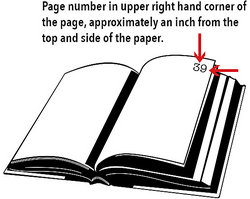In the Chicago Manual of Style, manuscript page numbers may be placed in several different locations. The most conventional place to find them is in the upper right hand corner, along with the last name of the writer. However, some editors may prefer a more unconventional placement.
Chicago Manual of Style: Page Numbers
The most conventional location of the page numbers is the upper right hand corner of the page, approximately an inch from the top and side of the paper.
They can sometimes be found on the top left or at the bottom of a page, either centered, flush left or flush right. Page numbers located at the bottom of a page are also called drop folios. As unconventional placements, these would be at the discretion of the editor.
Certain pages have no pages numbers but are still included in the page numbering. These pages include:
- Front matter pages
- Chapter beginnings
- Pages carrying only illustrations or tables
- Part title pages
- Color illustrations or plates that are inserted after all printed material of the manuscript has complete
Although the page number placement may vary, always check with your editor to find their preference. Otherwise, default to the top right hand corner of the page.
Alternate Page Numbering
When examining page numbering according to the Chicago Manual of Style, it should also be noted that different numbering schemes are used depending on the section of the manuscript involved.
- Pages in the manuscript front matter, such as the title page, copyright page and others, are numbered using lower case Roman numerals (i, ii, iii).
- Pages in the text of the manuscript and the back matter, such as notes, glossary, and index(es), are numbered in Arabic numerals (1, 2, and 3).
In general, there are several correct placements for page numbers according to the Chicago Manual of Style. These choices could be made by the editor, publisher and typesetter.

 Where Do Page Numbers Go In A Chicago Manual Of Style Manuscript
Where Do Page Numbers Go In A Chicago Manual Of Style Manuscript
